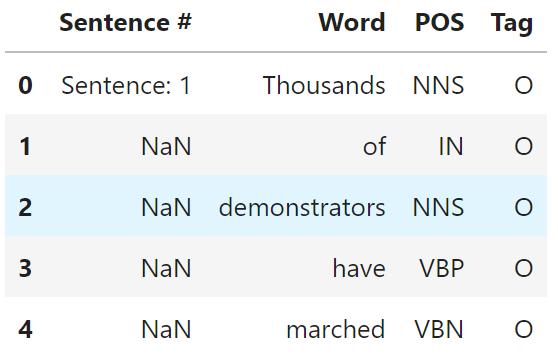NER = 命名实体识别
数据集:Kaggle:Annotated Corpus for Named Entity Recognition
import pandas as pd
from tensorflow import keras
import numpy as np
用Pandas
df = pd.read_csv('ner_dataset.csv',encoding='unicode-escape')
df.head()
输出:

获唯一标签,创建查找字典(标签转成类别编号)
tags = df.Tag.unique()
tags
输出:
array(['O', 'B-geo', 'B-gpe', 'B-per', 'I-geo', 'B-org', 'I-org', 'B-tim',
'B-art', 'I-art', 'I-per', 'I-gpe', 'I-tim', 'B-nat', 'B-eve',
'I-eve', 'I-nat'], dtype=object)
id2tag = dict(enumerate(tags))
tag2id = { v : k for k,v in id2tag.items() }
id2tag[0]
输出:'0'
对词表操作,创建不考虑词汇的词表(实战要用Keras向量化器,限制词汇数量)
vocab = set(df['Word'].apply(lambda x: x.lower()))
id2word = { i+1 : v for i,v in enumerate(vocab) }id2word[0] = '<UNK>'vocab.add('<UNK>')
word2id = { v : k for k,v in id2word.items() }
创还能用来训练句子的数据集,遍历原始数据集,独立句子分成X(词列表)和Y(标签列表)
X,Y = [],[]
s,t = [],[]
for i,row in df[['Sentence #','Word','Tag']].iterrows():
if pd.isna(row['Sentence #']):
s.append(row['Word'])
t.append(row['Tag'])
else:
if len(s)>0:
X.append(s)
Y.append(t)
s,t = [row['Word']],[row['Tag']]X.append(s)Y.append(t)
向量化所有单词和token:
def vectorize(seq):
return [word2id[x.lower()] for x in seq]
def tagify(seq):
return [tag2id[x] for x in seq]
Xv = list(map(vectorize,X))Yv = list(map(tagify,Y))
Xv[0], Yv[0]
输出:
([10386,
23515,
4134,
29620,
7954,
13583,
21193,
12222,
27322,
18258,
5815,
15880,
5355,
25242,
31327,
18258,
27067,
23515,
26444,
14412,
358,
26551,
5011,
30558],
[0, 0, 0, 0, 0, 0, 1, 0, 0, 0, 0, 0, 1, 0, 0, 0, 0, 0, 2, 0, 0, 0, 0, 0])
所有句子用0填充到最大长度(实战要用别的策略,本实验只是简化版)
X_data = keras.preprocessing.sequence.pad_sequences(Xv,padding='post')
Y_data = keras.preprocessing.sequence.pad_sequences(Yv,padding='post')
定义标记分类网络(Token分类网络):
双层双向LSTM:输入(词嵌入序列),输出(时间步LSTM输出用TimeDistributed层用相同的全连接分类器)
return_sequences=True:LSTM返回时间步输出
TimeDistributed:全连接层独立处理时间步特征
代码:
maxlen = X_data.shape[1]vocab_size = len(vocab)num_tags = len(tags)model = keras.models.Sequential([
keras.layers.Embedding(vocab_size, 300, input_length=maxlen),
keras.layers.Bidirectional(keras.layers.LSTM(units=100, activation='tanh', return_sequences=True)),
keras.layers.Bidirectional(keras.layers.LSTM(units=100, activation='tanh', return_sequences=True)),
keras.layers.TimeDistributed(keras.layers.Dense(num_tags, activation='softmax'))])
model.compile(loss='sparse_categorical_crossentropy',optimizer='adam',metrics=['acc'])model.summary()
输出:
Model: "sequential_3"
_________________________________________________________________
Layer (type) Output Shape Param #
=================================================================
embedding_4 (Embedding) (None, 104, 300) 9545400
bidirectional_6 (Bidirectio (None, 104, 200) 320800
nal)
bidirectional_7 (Bidirectio (None, 104, 200) 240800
nal)
time_distributed_3 (TimeDis (None, 104, 17) 3417
tributed)
=================================================================
Total params: 10,110,417
Trainable params: 10,110,417
Non-trainable params: 0
固定序列长度:指定maxlen通义输出长度,但是不能处理现场序列(可能引入冗余填充)
变长序列处理:Masking层或动态填充(按批次处理),调整网络结构支持动态输入
model.fit(X_data,Y_data)
输出:<keras.callbacks.History at 0x16f0bb2a310>
训练结果:
sent = 'John Smith went to Paris to attend a conference in cancer development institute'
words = sent.lower().split()
v = keras.preprocessing.sequence.pad_sequences([[word2id[x] for x in words]],padding='post',maxlen=maxlen)
res = model(v)[0]
r = np.argmax(res.numpy(),axis=1)
for i,w in zip(r,words):
print(f"{w} -> {id2tag[i]}")
输出:
john -> B-per
smith -> I-per
went -> O
to -> O
paris -> B-geo
to -> O
attend -> O
a -> O
conference -> O
in -> O
cancer -> B-org
development -> I-org
institute -> I-org
扩展学习:
-
医学术语NER模型实验